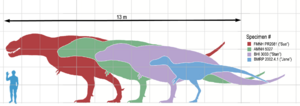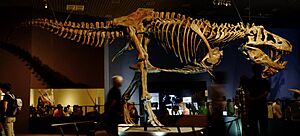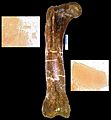Tyrannosaurus facts for kids
Quick facts for kids TyrannosaurusTemporal range:
Upper Cretaceous 68–66 mya |
|
|---|---|
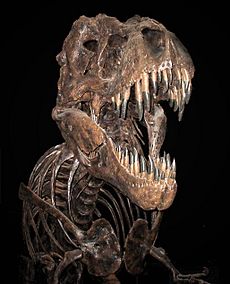 |
|
| Skeleton at the National Museum of Natural History, Washington, D.C. |
|
| Scientific classification | |
| Kingdom: | |
| Class: | |
| Superorder: | |
| Order: | |
| Suborder: | |
| (unranked): | |
| Family: | |
| Genus: |
Tyrannosaurus
Osborn, 1905
|
| Species: |
Tyrannosaururus rex
Osborn, 1905
|
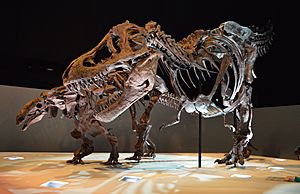
Houston Museum of Natural History
Tyrannosaurus was a huge meat-eating dinosaur. It lived about 68 to 66 million years ago, during the late Cretaceous Period.
Tyrannosaurus walked on two strong legs. It was a carnivore (meat-eater) with a very big head. Its long, heavy tail helped it balance. Its front arms were small, but they were strong for their size and had two claws.
Scientists have found more than 30 skeletons of Tyrannosaurus rex. Some of these skeletons are almost complete. In some cases, even soft tissues and proteins have been found. Scientists study these fossils to learn about the dinosaur's life, how it moved, and what it ate. There is still some debate about how fast it could run. Some scientists think that Tarbosaurus bataar from Asia might be another type of Tyrannosaurus. Others believe Tarbosaurus is a completely different kind of dinosaur.
Contents
How Big Was Tyrannosaurus?
The estimated size of this dinosaur has changed many times. Scientists have found that older ways of guessing dinosaur weight might have made them seem heavier than they really were. So, Tyrannosaurus' might have weighed less than once thought.
Tyrannosaurus rex was the largest known tyrannosaurid. It was also one of the biggest land predators ever. It could be up to 12.3 meters (40 feet) long. It stood about 4 meters (13 feet) tall at its hips. It could weigh up to 6.8 metric tons (7.5 short tons). Tyrannosaurus rex was the biggest meat-eater in its environment. It was likely a top predator, hunting hadrosaurs and ceratopsians. It might also have eaten dead animals as a scavenger. Scientists have debated for a long time whether Tyrannosaurus was mainly a hunter or a scavenger.
For many years, Tyrannosaurus was thought to be the largest meat-eating dinosaur. But recently, scientists have found skeletons of other carnivores that were slightly bigger. These include Giganotosaurus, Spinosaurus, and Carcharodontosaurus. Tyrannosaurus skeletons have been found in North America. But its relatives, like Tarbosaurus, have been found in Asia.
The Tyrannosaurus Skull
The largest known Tyrannosaurus rex skulls are up to 1.5 meters (5 feet) long. Like other meat-eating dinosaurs, its skull had large openings called 'fenestrae'. These holes made the skull lighter and gave space for strong muscles to attach.
But the Tyrannosaurus skull was different from other large meat-eaters. It was very wide at the back but had a narrow snout. This shape gave it good binocular vision, meaning it could see well with both eyes, like humans. The bones in its skull were very thick and strong. Some bones were fused together, so they couldn't move. Many bones also had tiny air spaces inside, like a honeycomb. This might have made the bones lighter and more flexible. All these features helped Tyrannosaurus have an incredibly powerful bite. Its bite was much stronger than any other non-tyrannosaurid dinosaur.
The front of its upper jaw was U-shaped. Most other meat-eating dinosaurs had V-shaped upper jaws. The U-shape allowed Tyrannosaurus to rip out more flesh and bone with one bite.
What Did Tyrannosaurus Eat?
As the largest meat-eater in its area, Tyrannosaurus rex was most likely a top apex predator. It probably hunted plant-eating dinosaurs like hadrosaurs and young armored dinosaurs such as ceratopsians and ankylosaurs. It might have also hunted sauropods. Some experts have suggested that Tyrannosaurus mostly ate dead animals as a scavenger. The question of whether Tyrannosaurus was a hunter or a scavenger was one of the longest debates in paleontology. Today, most paleontologists agree that Tyrannosaurus was both a hunter and a scavenger.
First Discoveries
The first Tyrannosaurus skeletons were found in 1902 by a scientist named Barnum Brown. In 1905, Henry Fairfield Osborn, who was the president of the American Museum of Natural History, gave the species its name: Tyrannosaurus rex. This name means "tyrant lizard king."
The most complete Tyrannosaurus skeleton was found in 1990 in South Dakota. It was named "Sue" after the person who found it, Susan Hendrickson.
Tyrannosaurus has become very famous. It has appeared in many movies and TV shows, like Jurassic Park. Its skeletons are popular displays in many museums around the world.
Tyrannosaurus became extinct during the Cretaceous–Tertiary extinction event. This event wiped out half of all species on Earth.
Jane
Jane is a fossil of a small tyrannosaurid. Scientists are still debating if it is a young Tyrannosaurus or a different type of dinosaur called Nanotyrannus. The skeleton was found in 2001 in the Hell Creek Formation in southern Montana.
It took experts four years to prepare the partial skeleton for a museum. Jane is now on display at the Burpee Museum of Natural History in Rockford, Illinois. Some paleontologists think Jane was about 11 years old when she died. Jane is 6.5 meters (21.5 feet) long, which is about half the length of the largest known adult T. rex. Experts believe Jane weighed about 680 kilograms (1,500 pounds). Her large feet and long legs suggest she could run quite fast, perhaps 32–48 kilometers per hour (20–30 miles per hour). Her lower jaw has 17 teeth that are curved and serrated (like a saw).
Scientists named her 'Jane' even though they don't know if she was male or female. She was named after Jane Solem, a person who helped the Burpee Museum.
The Jane fossil is part of a big argument among scientists. They disagree about whether Nanotyrannus is a separate type of tyrannosaurid. Jane's skull is very similar to the skull of the original Nanotyrannus fossil. This suggests they are the same species. In 2005, the Burpee Museum held a meeting where paleontologists discussed if these "pygmy tyrants" were adult dinosaurs from a small species or just young Tyrannosaurus rexes. A few scientists thought they were adults of a small species, but most decided they were probably young T. rexes. However, scientists are still studying Jane. Robert T. Bakker and his team are working on it.
Scotty
In August 1991, a high school principal named Robert Gebhardt joined scientists from the Royal Saskatchewan Museum. They were looking for fossils in the Frenchman River Valley in southwest Saskatchewan, Canada.
Gebhardt found the base of a tooth and a tail vertebra (backbone). Both looked like they belonged to a T. rex.
In June 1994, the museum scientists started digging up the T. rex. This 66-million-year-old skeleton was the first T. rex found in Saskatchewan. At the time, it was one of only 12 known in the world. This dinosaur, named Scotty, is one of the largest and most complete T. rex skeletons ever found, with almost 70% of its bones recovered. A full copy of the skeleton was finished in 2012. It is now on display at its permanent home, the T.rex Discovery Centre in Eastend, Saskatchewan, Canada.
Scotty's skull has a scar from its eye socket to its nostril. This injury was probably caused by another T. rex or a large meat-eater biting Scotty's head. Museum staff believe Scotty is the biggest T. rex specimen found. It weighed about 8,870 kilograms (9.78 tons). Scotty was probably in its early thirties when it died. It was about 13 meters (43 feet) long, including its tail.
Tyrannosaurus in Movies and Books
Tyrannosaurus rex appears in many stories and movies. A T. rex is a key part of the story in A Sound of Thunder by Ray Bradbury. A T. rex is also a big part of the book Jurassic Park by Michael Crichton. For the movie version of Jurassic Park, director Steven Spielberg's team built a life-sized robot T. rex and also used computer-generated images (CGI) to create the dinosaur. Many other T. rexes have appeared in books, movies, and animated shows.
Related pages
Images for kids
-
The 11-year-old juvenile "Jane" specimen, with an adult T. rex in the background, at the Burpee Museum of Natural History.
-
An older drawing (by Charles R. Knight) showing an outdated, upright pose for T. rex.
-
A T. rex thigh bone (MOR 1125) from which scientists found demineralized material and peptides.
-
A likely footprint from a Tyrannosaurus found in New Mexico.
-
The only known trackway (footprints) made by a tyrannosaurid (Bellatoripes fredlundi), from the Wapiti Formation, British Columbia.
-
The foot of a T. rex showing its unique middle metatarsal bone, compared to that of an Allosaurus.
-
The eye-sockets faced mostly forward, giving it good binocular vision (the Sue specimen).
-
A cast of the braincase at the Australian Museum, Sydney.
-
The skeleton of Bucky and a cast of Stan, at The Children's Museum of Indianapolis.
See also
 In Spanish: T-rex para niños
In Spanish: T-rex para niños




